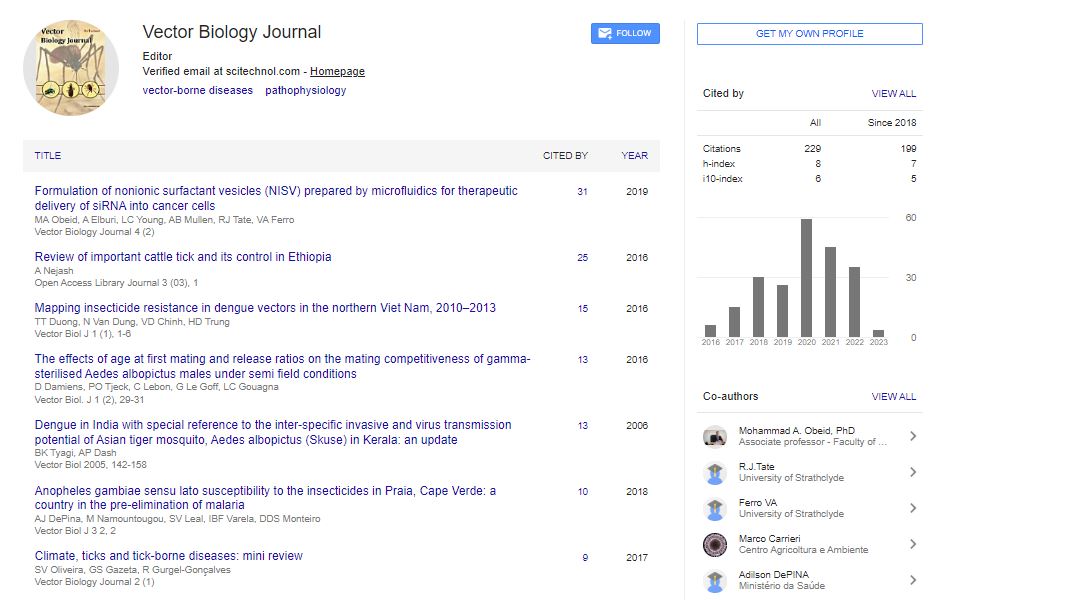Commentary, Vector Biol J Vol: 10 Issue: 1
The Role of Vector Competence in Mosquito-Mediated Disease Dynamics
Zhou Hung*
Department of Biology, Institute of Infectious Diseases, China
- *Corresponding Author:
- Zhou Hung
Department of Biology, Institute of Infectious Diseases, China
E-mail: hung.zho@gmail.com
Received: 01-Mar-2025, Manuscript No. VBJ-22-169490, Editor assigned: 03-Mar-2025, PreQC No. VBJ-22-169490(PQ), Reviewed: 17-Mar-2025, QC No. VBJ-22-169490, Revised: 21-Mar-2025, Manuscript No. VBJ-22- 169490(R), Published: 28-Mar-2025, DOI: 10.4172/2473-4810.1000335
Citation: Zhou H (2025) The Role of Vector Competence in Mosquito- Mediated Disease Dynamics. Vector Biol J 10: 335
Abstract
Mosquitoes are widely regarded as the most dangerous animals on
Earth due to their role in transmitting deadly diseases such as malaria,
dengue fever, Zika virus, chikungunya, and yellow fever. These diseases
collectively affect hundreds of millions of people globally every year
and account for substantial morbidity and mortality. Mosquitoes
act as vectors, organisms that transmit pathogens between humans or
from animals to humans. Their ability to transmit disease is governed
by several factors, including vector competence, environmental
conditions, and host availability. Understanding mosquito biology
and vector competence is essential for developing targeted strategies
to reduce the transmission of mosquito-borne diseases.
Keywords: Mosquitoes, Malaria, Zika virus, Morbidity, Mortality
Introduction
Mosquitoes are widely regarded as the most dangerous animals on Earth due to their role in transmitting deadly diseases such as malaria, dengue fever, Zika virus, chikungunya, and yellow fever. These diseases collectively affect hundreds of millions of people globally every year and account for substantial morbidity and mortality [1]. Mosquitoes act as vectors, organisms that transmit pathogens between humans or from animals to humans. Their ability to transmit disease is governed by several factors, including vector competence, environmental conditions, and host availability [2]. Understanding mosquito biology and vector competence is essential for developing targeted strategies to reduce the transmission of mosquito-borne diseases.
Description
Vector competence refers to the intrinsic ability of a mosquito to acquire, maintain, and eventually transmit a specific pathogen. This competence is influenced by the mosquitoâ??s genetics, physiology, immune response, and interactions with microbial communities within the mosquitoâ??s gut [3]. Not all mosquito species are capable of transmitting all pathogens. For instance, Aedes aegypti is the primary vector of dengue, Zika, and chikungunya viruses due to its close adaptation to urban environments and preference for human hosts. Meanwhile, Anopheles gambiae is the principal vector for Plasmodium falciparum, the parasite responsible for the most lethal form of malaria [4].
The mosquitoâ??s lifespan, frequency of blood feeding, and the extrinsic incubation period of the pathogen all play vital roles in transmission dynamics. If the mosquito dies before the pathogen completes its development, transmission does not occur. Environmental factors such as temperature and humidity also affect mosquito survival and the development rate of the pathogen within the mosquito [5]. Warmer temperatures can accelerate the extrinsic incubation period, increasing the likelihood of disease spread.
Discussion
Efforts to control mosquito-borne diseases historically rely on reducing mosquito populations or preventing mosquito-human contact. The use of insecticides, such as pyrethroids and organophosphates, has been widespread in indoor residual spraying and insecticide-treated bed nets. However, over-reliance on these chemicals has led to widespread insecticide resistance in mosquito populations [1]. Therefore, novel control strategies have gained attention.
One such innovation is the use of Wolbachia, a bacterium that, when introduced into Aedes aegypti populations, can interfere with virus replication and reduce transmission capacity. Field trials in countries such as Indonesia and Brazil have demonstrated significant reductions in dengue incidence following Wolbachia release programs [2]. Genetic modification and gene drive technologies are also being explored to reduce mosquito fertility or render mosquitoes incapable of transmitting specific pathogens.
Urban planning and environmental management are additional components of vector control. Removing standing water, proper waste disposal, and improved housing can drastically reduce mosquito breeding habitats. Furthermore, community engagement and education campaigns enhance the sustainability of these interventions [3].
Recent developments in remote sensing, GIS, and machine learning have enabled better prediction of mosquito population surges and potential disease outbreaks. These tools assist in early warning systems and targeted intervention strategies, particularly in resource-limited settings [4], [5]. Continued investment in surveillance, diagnostics, and integrated vector management is crucial.
Conclusion
Mosquito-borne diseases remain a major global health concern, especially in tropical and subtropical regions. Vector competence, driven by genetic, biological, and environmental factors, plays a pivotal role in transmission dynamics. While traditional control measures like insecticides remain important, innovative approaches such as Wolbachia, genetic engineering, and community-based interventions show great promise. An interdisciplinary, integrated approach is essential for sustainable control of mosquito-borne diseases in the face of emerging threats such as climate change and urbanization.
References
- Lee KK, Jharap B, Maser EA, Colombel JF (2016)Impact of concomitant endometriosis on phenotype and natural history of inflammatory bowel disease. Inflamm Bowel Dis22: 159-163.
- Zondervan KT, Becker CM, Koga K, Missmer SA, Taylor RN, et al. (2018) Endometriosis. Nat Rev Dis Primers4: 9.
- Stephansson O, Falconer H, Ludvigsson JF (2011) Risk of endometriosis in 11, 000 women with celiac disease. Hum Reprod26: 2896-2901.
- Selam B, Kayisli UA, Garcia-Velasco JA, Arici A (2002)Extracellular matrix-dependent regulation of Fas ligand expression in human endometrial stromal cells. Biol Reprod66: 1-5.
- Sampson JA 1927.Peritoneal endometriosis due to the menstrual dissemination of endometrial tissue into the peritoneal cavity. Am J Obstet Gynecol14: 422â??469.
Indexed at, Google Scholar, Crossref
Indexed at, Google Scholar, Crossref
Indexed at, Google Scholar, Crossref
Indexed at, Google Scholar, Crossref
 Spanish
Spanish  Chinese
Chinese  Russian
Russian  German
German  French
French  Japanese
Japanese  Portuguese
Portuguese  Hindi
Hindi 